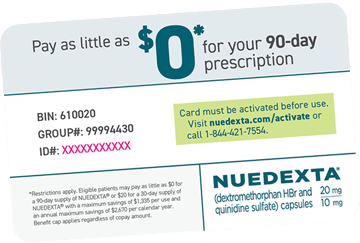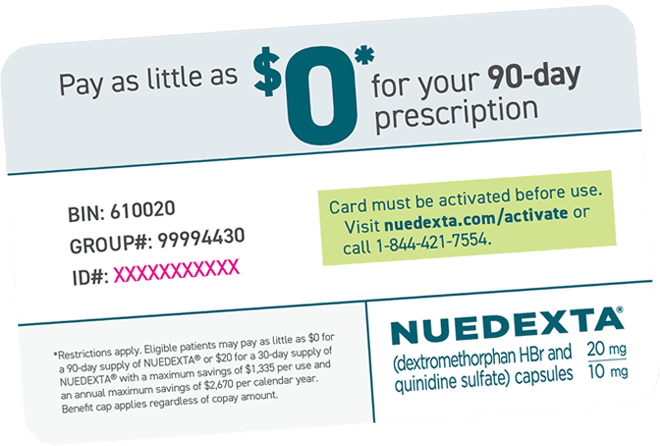ABOUT PSEUDOBULBAR AFFECT (PBA)

What is Pseudobulbar Affect (PBA)?
Terminology used to answer "what is PBA?" has varied in the scientific literature, which has contributed to debate and confusion. Commonly used terms include involuntary emotional expression disorder, emotional lability, affective lability, emotional dysregulation, pathological laughter and crying, emotional dysregulation, emotional incontinence, and emotionalism.1,2 The condition is called “pseudobulbar” because it is associated with damage to the corticobulbar tract in the brain.4
To provide your patients with a proper diagnosis, it is important to understand PBA’s definition and recognize the underlying neurologic conditions most commonly associated with PBA.
What is PBA?
Pseudobulbar Affect is a neurologic condition that can occur secondary to other neurologic conditions or brain injuries. PBA is characterized by involuntary, sudden, frequent laughing and/or crying that is exaggerated or incongruent with the underlying mood.3
PBA is often comorbid with mood-related disorders such as depression.4-6

PBA symptoms are prevalent in patients with various underlying neurologic conditions
PBA most commonly affects patients who have been diagnosed with stroke, dementia or Alzheimer’s disease, traumatic brain injury (TBI), Parkinson’s disease, amyotrophic lateral sclerosis (ALS), and multiple sclerosis (MS). 3, 7
37%
of patients
In 2011, the prevalence of PBA in the U.S. was approximately 2 million cases among patients with underlying neurologic conditions or brain injury. In a multicenter registry (N=5,290), 37% of patients with any one of six associated neurologic conditions scored a Center for Neurologic Study-Lability Scale (CNS-LS) score of 13 or greater, suggesting the presence of PBA symptoms.3,7,a
Presence of PBA laughing and/or crying symptoms in select neurologic conditions7, a
| Neurologic Condition (n, mean age of patients) |
CNS-LS ≥ 13 | CNS-LS ≥ 21 | Mean years from primary condition diagnosis to study enrollment |
|---|---|---|---|
| Traumatic brain injury (n=590, 46 yrs) |
52% | 16% | 10.3 (n=347) |
| Multiple sclerosis (n=1,215, 49 yrs) |
46% | 12% | 9.9 (n=785) |
| Amyotrophic lateral sclerosis (n=125, 60 yrs) |
45% | 12% | 2.3 (n=108) |
| Stroke (n=757, 68 yrs) |
38% | 9% | 4.6 (n=395) |
| Alzheimer's disease (n=1,799, 79 yrs) |
29% | 7% | 3.7 (n=656) |
| Parkinson's disease (n=804, 73 yrs) |
26% | 6% | 5.3 (n=386) |
a For more information on the CNS-LS and how it was used, see the PRISM Study Design below.
How many of your patients have symptoms of PBA?
The information below shows how many people in the U.S. may have laughing and/or crying symptoms suggestive of PBA. It’s also important to understand how PBA symptoms can be mischaracterized for symptoms of depression or of an underlying neurologic condition so that you can make an accurate diagnosis.
| Neurologic Condition | PRISM Study7 CNS-LS ≥ 13 |
Estimated incidence or prevalence in the United States |
|---|---|---|
| Traumatic brain injury (n=590, 46 yrs) |
Up to 52% (may have symptoms suggestive of PBA) |
As many as 2.9 million people in the U.S. were diagnosed with a TBI in 2014 at emergency department visits, hospitalizations, and death.14 |
| Multiple sclerosis (n=1,215, 49 yrs) |
Up to 46% (may have symptoms suggestive of PBA) |
Nearly 1 million Americans are living with MS.18 |
| Amyotrophic lateral sclerosis (n=125, 60 yrs) |
Up to 45% (may have symptoms suggestive of PBA) |
About 5,000 Americans are diagnosed every year, with over 30,000 currently living with ALS.16,17 |
| Stroke (n=757, 68 yrs) |
Up to 38% (may have symptoms suggestive of PBA) |
Each year, more than 795,000 people in the U.S. have a stroke, which is a leading cause of long-term disability.10 |
| Alzheimer's disease (n=1,799, 79 yrs) |
Up to 29% (may have symptoms suggestive of PBA) |
More than 6 million people in the U.S. are believed to have Alzheimer’s disease.12 |
| Parkinson's disease (n=804, 73 yrs) |
Up to 26% (may have symptoms suggestive of PBA) |
Nearly 1 million Americans are living with Parkinson’s disease.15 |
PBA symptom prevalence in the long-term care setting may differ.20
Read more about PBA in the long-term care setting
PBA is a distinct condition that should be diagnosed and treated separately from these other underlying neurologic conditions or brain injuries.
Once you've made a PBA diagnosis, you can document your decision with ICD-10 code F48.2.19
Understanding PBA
As a healthcare provider, Dr. Fisher shares his experience with PBA patients.







